
Aeger is a genus of fossil prawns. They first occur in the Middle Triassic, and died out at the end of the Late Cretaceous. A total of 21 species are known.
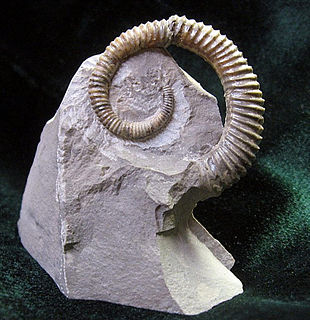
Allocrioceras is an ammonoid cephalopod from the Turonian to Santonian stages of the Late Cretaceous, included in the turrilitoid family Anisoceratidae. Its shell is strongly ribbed and is in the form of a widely open spiral.
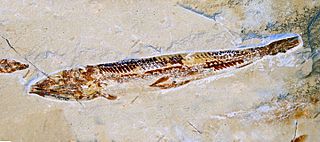
Prionolepis is a genus of prehistoric ray-finned fish belonging to the order Alepisauriformes.

Eupodophis is an extinct genus of snake from the Late Cretaceous period. It has two small hind legs and is considered a transitional form between Cretaceous lizards and limbless snakes. The feature, described as vestigial, was most likely useless to Eupodophis. The type species Eupodophis descouensi was named in 2000 and resides now in the paleontology section of the Mim Museum in Beirut, Lebanon. The specific name is dedicated to the French naturalist Didier Descouens.

Rhachiberothidae, sometimes called thorny lacewings, are a family of winged insects in the order Neuroptera. The family has only 14 extant species in 4 genera found in Sub-Saharan Africa, but has a diverse fossil record extending back to the Early Cretaceous in Lebanon, Eurasia and North America. Like the closely related Mantispidae members of the group possess raptorial forelegs, which probably only evolved once in the common ancestor of the groups.
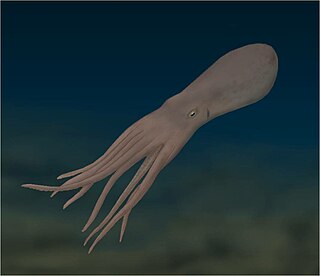
Keuppia is an extinct genus of octopus.

Aegeridae is a family of fossil prawns. It contains two genera, Aeger and Acanthochirana.
Cretasergestes sahelalmaensis is an extinct species of prawn which existed in Lebanon during the Late Cretaceous period, the only species in the genus Cretasergestes.

Hakelocaris vavassorii is an extinct species of prawn belonging to the family Penaeidae. It was named in 1994 by Alessandro Garassino, and is the only species in the genus Hakelocaris.
Macropenaeus is an extinct genus of prawn in the order Decapoda, containing two species: the type species M. incertus, known from the Late Cretaceous (Cenomanian) of Lebanon, and M. sidiaichensis known from the Early Cretaceous (Barremian) of Tunisia.
Enantiophoenix is a genus of enantiornithine birds. Fossil remains were recovered from Lebanon. Lumps of amber preserved with one specimen indicate it may have fed on tree sap.
Microtuban is an extinct genus of azhdarchoid pterosaur known from the Late Cretaceous of northern Lebanon.
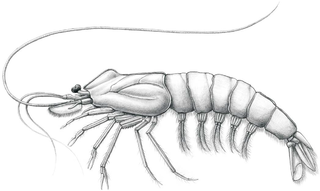
Palaeobenthesicymus is an extinct genus of prawns which existed in what is now Lebanon in the Late Santonian. It was described by Denis Audo and Sylvain Charbonnier in 2013, as a new genus for the species Penaeus libanensis, first described by P. Brocchi in 1875.

Hensodon spinosus is an extinct pycnodontid that lived during the Upper Cenomanian of what is now Lebanon. H. spinosus superficially resembled a marine angelfish with a massive head, and a very spiny pectoral girdle. Different specimens have different arrangements of the horn-like frontal spines. One form has the horns arranged as a double-prong, assumed to be the male, and the other form, assumed to be the female, having the horns one after the other, like those of a rhinoceros.

The Sclerogibbidae are a small family of aculeate wasps in the superfamily Chrysidoidea.
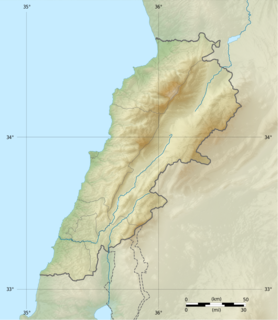
The Sannine Formation also called the Sannine Limestone is a Cretaceous geologic formation in Lebanon.

The El Doctor Formation is a geologic formation in Mexico. It preserves fossils dating back to the Albian and Cenomanian stages of the Cretaceous period.

Rhinochelys is an extinct genus of sea turtles belonging to the family Protostegidae.
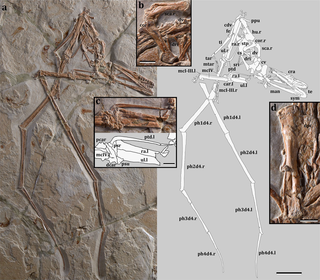
Mimodactylus is a genus of mimodactylid pterodactyloid pterosaur from the Late Cretaceous of what is now Lebanon.

Mimodactylidae is a group or family of pterosaurs known from Cretaceous deposits in East Asia and the Middle East. They are phylogenetically more closely related to the Istiodactylidae than to the Ornithocheiridae or the Anhangueridae, forming the clade Istiodactyliformes together with the Istiodactylidae and Hongshanopterus.














